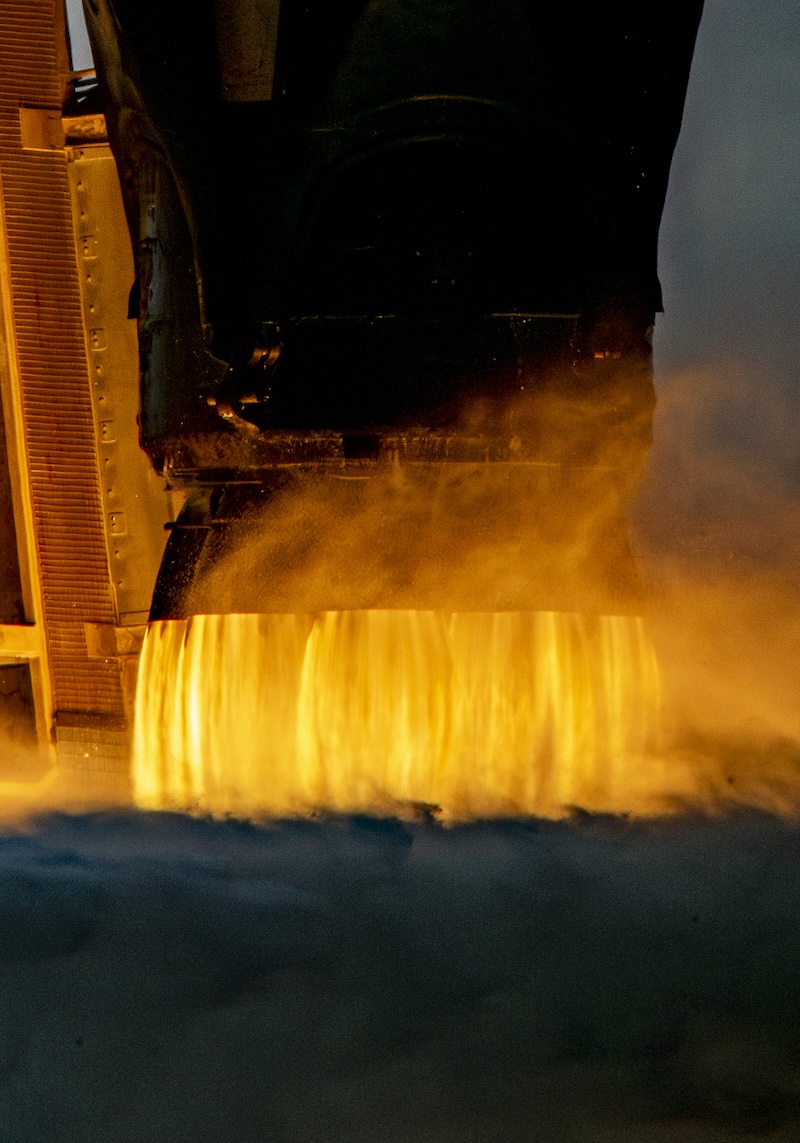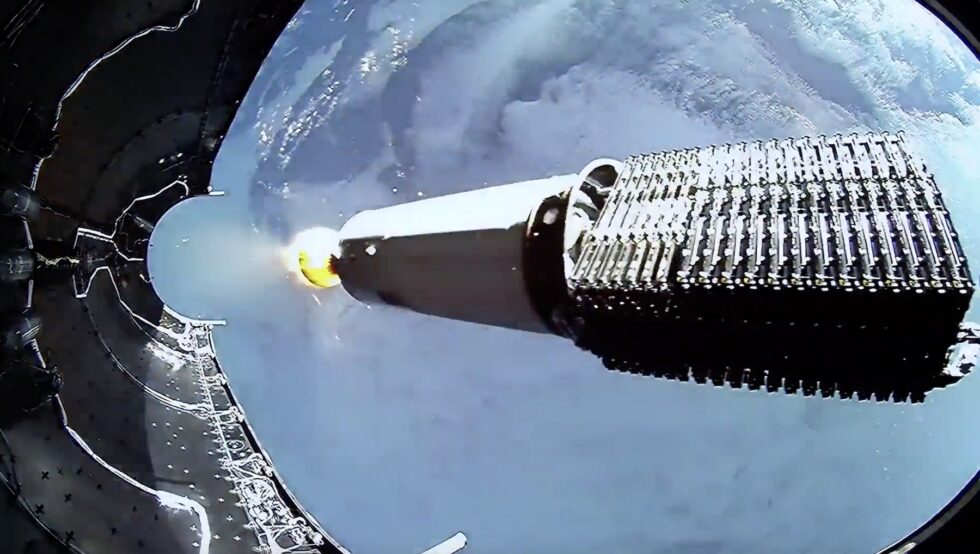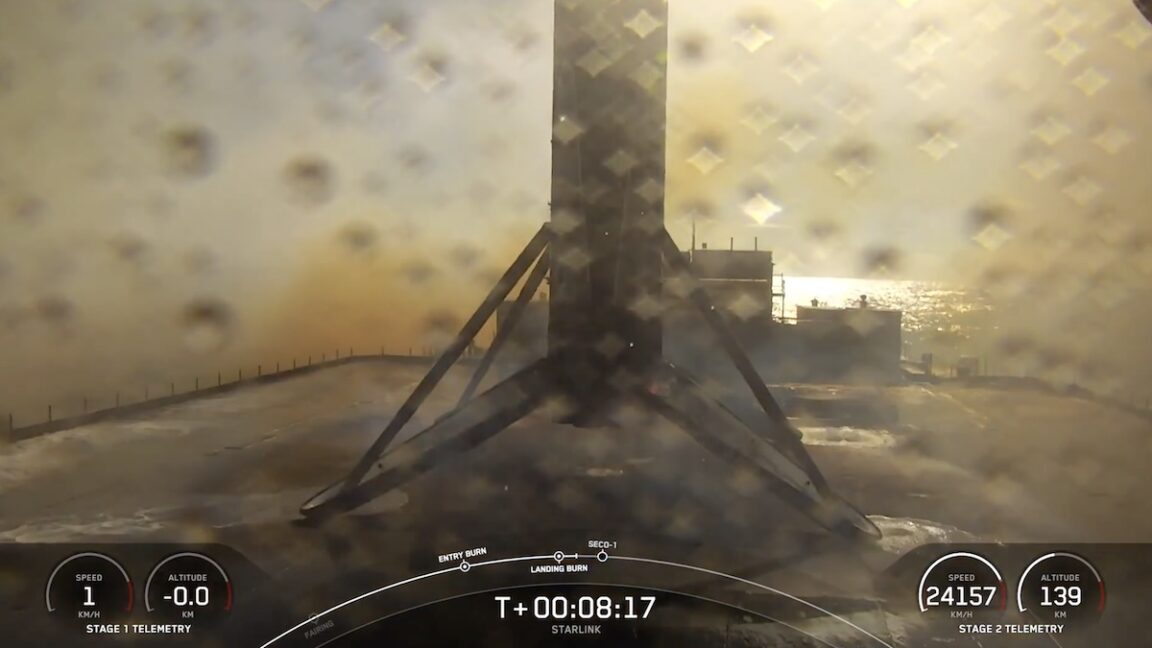SpaceX has launched one of its Falcon 9 boosters for a record-breaking 25th time.
On any given day, SpaceX is probably launching a Falcon 9 rocket, rolling one out to the launch pad or bringing one back into port. With three active Falcon 9 launch pads and an increasing cadence at the Starbase facility in Texas, SpaceX's teams are often doing all three.
The company achieved another milestone Friday with the 25th successful launch and landing of a single Falcon 9 booster. This rocket, designated B1067, launched a batch of 21 Starlink Internet satellites from Cape Canaveral Space Force Station, Florida.
The rocket's nine kerosene-fueled Merlin 1D engines powered the 21 Starlink satellites into space, then separated from the Falcon 9's upper stage, which accelerated the payload stack into orbit. The 15-story-tall booster returned to a vertical propulsive landing on one of SpaceX's offshore drone ships in the Atlantic Ocean a few hundred miles downrange from Cape Canaveral.
With the launch Friday and another Falcon 9 flight Monday (this one with a booster on its 15th mission), SpaceX has launched Falcon 9 rockets 423 times. The fleet leader, Booster No. 1,067, has now launched 457 satellites and eight astronauts over its 25 flights.
Ars has reported on these rocket reuse milestones before, but SpaceX is breaking its own records so often that we've dialed back on our coverage. SpaceX has now broken its own record for the number of flights by a single Falcon 9 booster five times in the last nine months.

Falcon 9’s success is about more than reusability
But SpaceX's accomplishment of 25 flights offers an opportunity to step back and take in some context. The newest and final iteration of the Falcon 9 design, known as Block 5, debuted in 2018. At the time, SpaceX officials said they planned to fly each booster 10 times before standing down for more thorough refurbishment.
SpaceX now plans to launch each Falcon 9 booster up to 40 times. Engineers temporarily removed two Falcon 9 boosters from SpaceX's launch rotation in 2023 for in-depth inspections after their 15th flight. That allowed SpaceX to extend each booster's certification to 20 flights, and last year, officials announced they were going for 40.
The only other US company that seems close to achieving rocket reuse is Jeff Bezos' Blue Origin, which has designed the first stage booster on the New Glenn rocket to fly 25 times. Blue Origin aims to launch the New Glenn rocket for the first time this week.
With more experience reusing Falcon 9 boosters, SpaceX has cut the turnaround time between flights of the same rocket. In November, SpaceX launched the same Falcon 9 booster twice in less than 14 days, the shortest turnaround time for a booster yet. The company has launched 38 missions with booster turnaround times of one month or less, and all but nine of those flights occurred within the last year.
But there's more to the story.
SpaceX is also recovering and reusing payload fairings, the shell that encloses satellite payloads during their initial climb through the atmosphere. Last month, the company confirmed it flew a fairing shell for the 22nd time, another new record. SpaceX's factory in Hawthorne, California, must also churn out new upper stages for each Falcon 9 and Falcon Heavy flight. That's 135 of these multimillion-dollar stages for each Falcon mission in the last 365 days, or one flight (and one new upper stage) every 2.7 days.

Ground crews must more quickly prepare the launch pad for another flight to achieve this kind of flight rate. Last year, SpaceX's shortest span between two launches from the same pad was less than three days. After each offshore landing, the drone ship must travel hundreds of miles from the downrange landing zone back to port in Florida or California, where a crane lifts the booster off the vessel. Then, the drone ship must return to sea as rapidly as possible.
Here are some of SpaceX's current turnaround records, and note they're all within the last year (all dates UTC):
• Shortest turnaround between two Falcon 9 launches from different pads: 1 hour, 5 minutes (August 31, 2024)
• Shortest time with three Falcon 9 launches: 20 hours, 3 minutes (March 4, 2024 and November 17–18, 2024)
• Shortest turnaround between launches from the same pad: 2 days, 15 hours, 53 minutes (November 11–14, 2024)
• Shortest turnaround of a drone ship between landings: 3 days, 12 hours, 13 minutes (May 28–June 1, 2024)
• Shortest turnaround of the same Falcon 9 booster: 13 days, 12 hours, 34 minutes (November 11–25, 2024)
None of these records are flukes. SpaceX has launched Falcon 9 rockets less than two hours apart on two occasions, and within a handful of hours several more times. Falcon 9 rockets have routinely launched from SpaceX's busiest launch pad—Space Launch Complex 40 in Florida—as little as three or four days apart.
When SpaceX landed twice on the same drone ship in three-and-a-half days last year, the company's vice president of launch, Kiko Dontchev, congratulated his team on X. The drone ship "traveled roughly 640 nautical miles in that time with only 3.5 hrs at the dock to drop off a rocket," he wrote.
At the beginning of last year, Dontchev posted on X that SpaceX rolled a rocket out of the hangar and launched it six-and-a-half hours later. At the time, that was the fastest rollout to launch, but we haven't had accurate rollout times for all missions since then. During the rollout, the rocket rides on a strongback transporter along rail tracks from the hangar to the launch pad, where it pivots vertically in preparation for the countdown to liftoff. On some missions, SpaceX has raised a rocket vertically in as little as four hours before launch for final checkouts and fueling.
A match made for the heavens
All of these statistics are remarkable, considering some rockets (such as the now-retired Delta IV Heavy from United Launch Alliance) have spent a year or more on the launch pad preparing for liftoff. The shortest span between two flights of ULA's expendable workhorse rocket, the Atlas V, from different pads was six days in 2015. SpaceX's fleet-leading booster, with 25 flights, has launched more times since its debut in June 2021 than all of ULA's missions in the same time period.
Rocket Lab, which flies a much smaller launcher than the Falcon 9, has launched two orbital missions from different spaceports within approximately seven-and-a-half days and from the same launch pad within about nine days.
SpaceX's rapid cadence wouldn't be possible without reusability, which allows the company to bring down costs and increase the launch rate. SpaceX's massive Starship rocket is designed to be fully reusable, further reducing costs and potentially resolving any concerns about production bottlenecks.
Imagine, for a moment, the sprawling footprint and bloated headcount of SpaceX's factory if it had to manufacture a new Falcon 9 booster, nine engines, and a payload fairing set every 2.7 days. How cost-effective could that be? Would it even be possible? It's mind-boggling enough to visualize the blistering production pace for Falcon 9's upper stages in Hawthorne or SpaceX's Starlink satellites in Redmond, Washington.
As far as we know, SpaceX doesn't have a plan to make reusable satellites. Some companies have interesting concepts for reusable satellites, but they are focused on in-space manufacturing instead of consumer services.

SpaceX's massive Starship rocket is designed to be fully reusable, further reducing the marginal cost of each flight and potentially resolving any concerns about production bottlenecks. But someone will still need to build Starships, and a lot of them.
Elon Musk, SpaceX's founder and CEO, has suggested that his company must produce 100 or more Starships per year to fulfill his Mars settlement ambitions, even with full reusability. When you think of the next-generation rocket factory, perhaps you should envision an airplane manufacturer, with multiple plants scattered around the country or globe.
With Falcon 9, SpaceX already produces more than 100 upper stages (and a handful of new boosters) each year. Starship is significantly larger and more sophisticated than a Falcon 9 upper stage, with higher-thrust, finely tuned Raptor engines and a heat shield that will be able to fly over and over again with no refurbishment. It will require larger buildings and likely, at least in the near term, more people on the manufacturing floor. Still, the Falcon 9's upper stage is a complicated piece of equipment.
Putting aside the drama and challenge of catching and re-flying rockets, the task of building so many spaceships in a year is a tall order. While SpaceX's competency with reusing Falcon 9 boosters gets a lot of attention—landing a rocket is still incredible, even after seeing it nearly 400 times—its manufacturing prowess with Falcon 9 upper stages suggests that building 100 Starships each year just might be doable someday.
Combining rocket reuse with high-rate manufacturing is fundamental for SpaceX's Starship ambitions, and it's already proving successful with Falcon 9. One might say it's a match made for the heavens.
Hope you enjoyed this news post.
Thank you for appreciating my time and effort posting news every day for many years.
News posts... 2023: 5,800+ | 2024: 5,700+
RIP Matrix | Farewell my friend ![]()



3175x175(CURRENT).thumb.jpg.b05acc060982b36f5891ba728e6d953c.jpg)
Recommended Comments
There are no comments to display.
Join the conversation
You can post now and register later. If you have an account, sign in now to post with your account.
Note: Your post will require moderator approval before it will be visible.